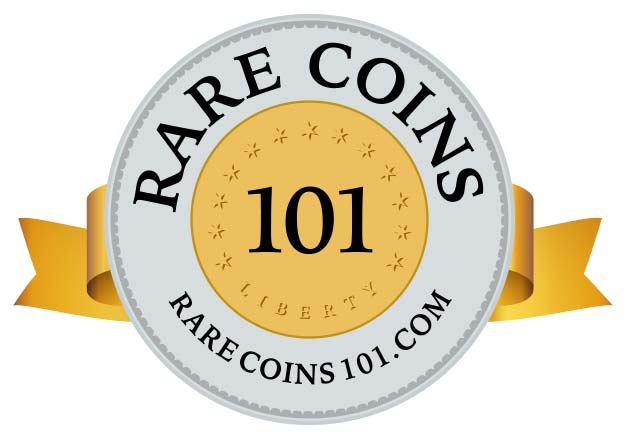1796 Draped Bust Small Eagle Half Dollar, 15 Stars
The story of the Draped Bust Small Eagle half dollars (1796 15 Stars, 1796 16 Stars, and 1797) are all closely related.
In 1796, the United States half dollar was switched from the Flowing Hair to the Draped Bust type. Initially, a small eagle reverse was carried but it was used only in 1796 and 1797. There was no more half dollar production until 1801, when the Draped Bust obverse was revived, but matched with a large eagle reverse.(1)
Mint documents do not specify how many half dollars were dated 1796 or 1797. Rather, their production figures were commingled. In all, just 3,918 Draped Bust Small Eagle half dollars were struck, and these were released during the calendar year of 1797.(2)
The tiny mintage of this coin type came about because most of the demand from bullion depositors during this time was for silver dollars.(3) Interestingly, the only depositor requesting half dollars in exchange for their silver was the Bank of the United States. The entire mintage of Draped Bust Small Eagle half dollars was delivered to that financial establishment.(4)
There are two major varieties of the 1796 half dollar. Chronologically, the first of these displays 15 stars on the obverse, one for each state in the Union at the time. Another star was added to the design after Tennessee became the 16th state on June 1, 1796.(5)
The concept of adding a star for every new state was soon abandoned when it became clear there would eventually be too many stars to fit on the nation’s coinage.
The Draped Bust Small Eagle half dollar was one of the coins sought by the earliest U.S. numismatists. As was true back then, most of the pressure today comes from type set specialists needing a representative of the two-year series.(6)
For type set collectors, either the 1796 15 Stars, 1796 16 Stars, or the 1797 fits the bill. The challenge is all are very rare. PCGS estimates there are less than 300 examples surviving today of Draped Bust Small Eagle half dollar.(7) All three dates are priced in the same ballpark.(8)
Rare Coins 101 has researched value trends of this early U.S. half dollar type back to 1950. It’s obvious buyers for a long time have not been shy about raising hands when an example hits the auction block. However, action has been unusually quiet since 2010, an anomaly that should not persist much longer.
| Estimated survivors in all grades: 75 ?
The survivor estimate from PCGS represents an average of one or more experts' opinions as to how many examples survive of a particular coin in all grades. Survival estimates include coins that are raw, certified by PCGS, and certified by other grading services. Learn more at PCGS. |
| PCGS Rarity Scale: 8.2 ?
The 'PCGS CoinFacts Rarity Scale' assesses the relative rarity of all U.S. coins, based on estimated surviving examples. The scale runs from 1.0 to 10.0. The higher the number, the rarer the coin.
Learn more at PCGS. |
| Click HERE to check for availability on eBay** |
Preview of eBay selection (you may have better luck finding an example for sale using the HERE link above):
 |
 |
| Trendline Avg = 8.71 | CLASSIC RARITY |
Historic Value Trend Charts:
| Last updated 5-11-24 | Return to Key Date Coin List | |
| There are no Common Date comparisons for this coin. | ||
|
|
||
| Download Charts to Your Computer | ||
Sources
1. Yeoman, R.S. and Garrett, Jeff, et al. A Guide Book of United States Coins, 75th ed. Pelham, AL: Whitman Publishing, 2021.
2. Heritage Auctions. 1796 50C 15 Stars. O-101. Feb 2008 Auction.
3. Garrett, Jeff and Guth, Ron. 100 Greatest U.S. Coins, 5th ed. Pelham, AL: Whitman Publishing, 2019.
4. Heritage Auctions. 1796 50C 15 Stars. O-101. Feb 2008 Auction.
5. Stack's Bowers Galleries. 1796 Draped Bust Half Dollar. O-101. May 2015 Auction.
6. NGC. Draped Bust Half Dollars (1796-1807).
7. PCGS. Draped Bust Half Dollar Type 1, Small Eagle.
8. Gibbs, William T., Managing Editor. Coin World Domestic Values. Sidney, OH. Amos Media Company. 2023.
**Many very fine coin dealers sell on eBay. At any point in time, there may be over one million search results for United States coins. This includes quite a few of the recommendations on our Key Date Coin List.
If you’re thinking about purchasing a rare coin, eBay is certainly worth a look. For your convenience, the links from this site to eBay are coded to bring up only coins certified by PCGS and NGC.
As is always, always the case, never buy a valuable coin from a seller whose trustworthiness cannot be verified. Learn more about this at our chapter Best Places to Buy Coins, which also has a section on doing business on eBay.
In the interest of full disclosure, Rare Coins 101 receives a small commission anytime someone connects to eBay from this site and purchases something.
Coin images by Stack's Bowers Galleries.


